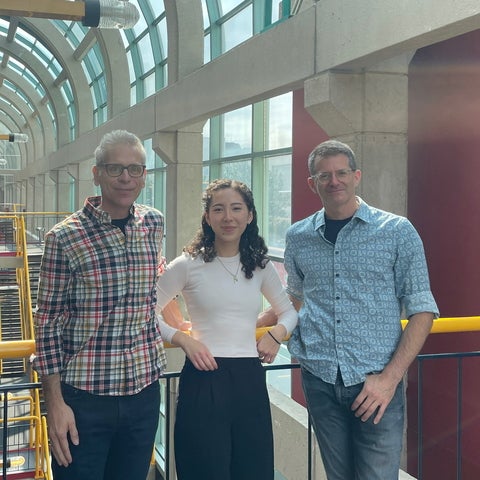What do you do?
I am a creative technologist at Antimodular Research, the Montreal-based studio of media artist Rafael Lozano-Hemmer. He creates large-scale interactive art installations for galleries and public spaces all around the world that includes computer-programmed elements. For example, his 2021 piece “Pulse Topology” invites viewers to use a pulse sensor, then translates their pulse into part of a canopy of light bulbs that light up in rhythm.
As a creative technologist, a lot of my day-to-day work is spent coding, like a software developer. I help preserve and update the technology behind Rafael’s older works – for example, updating face-recognition software – as well as helping him build out ideas and create new works. I also get to travel from time to time and help install the artworks, which is cool.
How did you end up at Waterloo?
I went to Mount Alison University in New Brunswick for undergrad, and did some research while I was there studying computer science. As I got closer to graduation I knew I wanted to learn more, and hoped that I could do research incorporating my interests. I’ve always loved art – I took painting lessons throughout my childhood, and enjoy all kinds of DIY projects – but it was just a hobby for me.
One of my professors at Mount Alison suggested I reach out to Professor Dan Vogel at Waterloo, because he has a fine arts degree in addition to a computer science degree. He was excited to work with me, and open to me doing research that incorporated art. I ended up being co-supervised by both Dan and Professor Craig S. Kaplan, who also does a lot of art-related research.
How did your work at Waterloo prepare you for your career?
For my master’s research I created a website called “Mindful Scroll,” which combined my interests in art, computer science and mindfulness. Mindful Scroll harnesses people’s doom-scrolling tendencies and instead invites them to meditatively colour in a series of infinitely scrolling geometric tiles. Working on that project really helped me think about the ways I could integrate my love of art and computer science, and it also gave me something specific that I could point to when I applied to this job.
I found my job through a website called Creative Jobs in Tech, which Craig directed me towards. I had done a couple of internships during my master’s and I knew I wanted to do something creative where I could see direct and tangible results of my work. I was excited when the job listing came up because it seemed like a really creative role, and I was already interested in living in Montreal. Having been part of the fantastic program we have here, as well as the support and mentorship of my supervisors, was really essential to me landing the job.

Saralin posing with her supervisors: Professors Daniel Vogel (left) and Craig S. Kaplan (right)
What connections do you see between computer science and art?
One thing I’ve always loved about computer science is the ability to create something tangible from just code, like a website or an app – or an interactive artwork! It’s why I enjoy coding so much. When you make a painting or another piece of art out of raw materials, and are able to look at this thing you made, it’s really fulfilling.
I also think that a lot of the patience and iterative processes that I learned in computer science are helpful in art as well. There are a lot of different ways you can approach things, and often you’ll end up trying different approaches until you find something that you like, that works out.
Art and computer science both involve a sort of freedom of expression. There’s rarely a single ‘right way’ to create something with code, just like there are endless possibilities when creating art. So there is a shared some level of creativity in how you approach a problem; that’s one of the reasons why I enjoy this work so much.
What advice do you have for current and future graduate students?
First of all, it was really important for me to learn time management and understand my work style. I recommend prioritizing work-life balance; it’s very easy when you’re in school to keep working at night, instead of treating it like a 9-5 job with boundaries. Learn when to stop and say, “I’ll finish this tomorrow.” Make sure you have hobbies and a life outside of school.
More specifically to computer science, make sure your research is something related to your interests or passions. I’m so grateful that I had great supervisors who encouraged me to do not just something computer science-related but also something rooted in my passion for art. So many different things are connected to computer science these days. Pursuing research I was passionate about left me really fulfilled, and opened the door for all kinds of interesting things in my career that I might not have been able to do otherwise.






